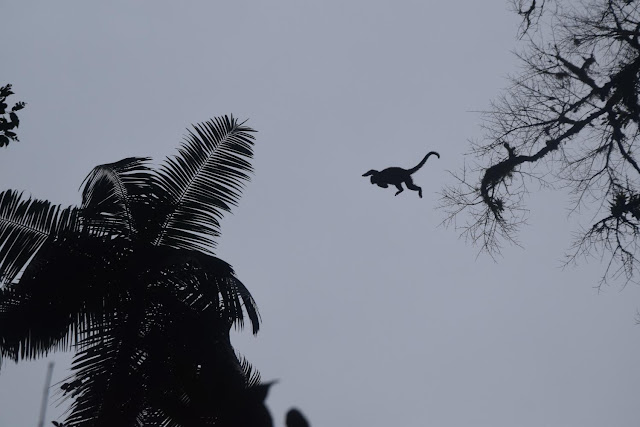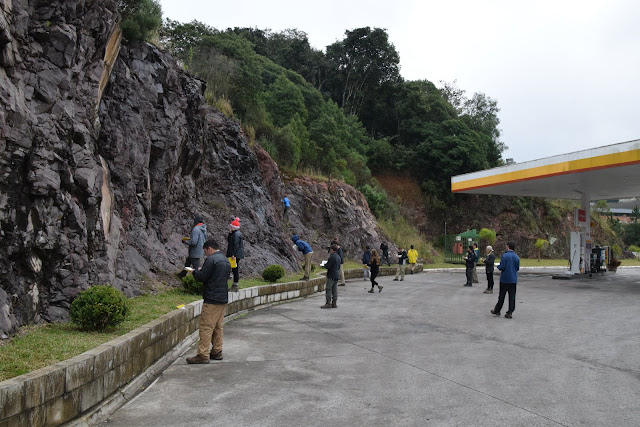This was it. The day we had been waiting for. All of our
training in hiking, climbing, spelunking and under-ground river crossing had
led us to this day. Arising before the dawn (5:30 breakfast time to be exact)
we embarked on our longest, most arduous field expedition to date. A two-and-a-half-hour
bus ride found us at the entrance of a relatively untamed park, covered in
dense rainforest, spotted with steep cliffs, and cut through the middle with an
array of rivers and streams. We were off the edge of the map now, especially
since Guil forgot to enforce rule number one today (Where are we?).
The past few days of excursion served us well as we traveled
largely without incident through jungles, fields, and bamboo forests. Minor
slips and skids found almost everyone on the trail as we tried to balance
ourselves out and keep from falling.
Most of us didn’t make it out…
The end of the hike to the caves offered a spectacular view
of a sinkhole, collapsed after years of slow erosion of the rock underlying the
surface of the land. Descent into the sinkhole was followed by a quick measurement
of the strike and dip (~ 205 degrees / 70 degrees northwest) of the rock features
composing the wall of the hole, and a routine field lunch (ham sandwiches were
replaced by salami today).
Then, it was time to go underground as we half slid, half
stumbled our way down into the depths of the cave. We were immediately greeted
by a variety of complex and beautiful cave formations unlike any we had seen before.
At the base of these was another novel structure known as a travertine, a
terrace-like formation composed of small grains of calcite, precipitated from
the evaporating droplets of water dripping from the ceiling as they flowed over
the cave floor. These travertines were particularly impressive to look at as
water, disturbed by Avarna and Lydia, flowed over their steps to the large
underground river below.
Next up was another part of the cave, where we found a large
basalt dike intruding into the cave rock.
Interestingly, this dike strikes East-West, which is uncommon as most
dikes in the region strike North-South, a characteristic feature of the East-West
splitting of South America and Africa. The return trip to the trail through the
cave involved several river crossings, which were handled expertly by the now well-adjusted
students, instructors, and guides of the Maymester.
As we exited the mouth of the cave, we were met by a strange
sound – a high-pitched whistling from one of our guides, Ditinho. The leaves of
the canopy rustled, and a similar sound projected out from the tops of the
trees. Three days of waiting and searching had finally paid off. It was a
family of Capuchin monkeys! Everyone immediately rushed along the trail to the
best vantage points to get a quick glimpse of the friendly primates. The hustle
was well worth it, as the majority of the group witnessed the whole group of
monkeys, including a mother with a baby wrapped around her chest, leap between
the trees right above our heads.
The most notable aspect of the hike, aside from the amazing geological formations and the monkeys, of course, was Emanuel’s infamous mid-race face plant. The guides who accompanied our group moved at a remarkably fast pace during this hike (we think they were trying to see if we could keep up), but after a bit of egging on by the Trio (Emanuel, XJ, and Matan), the race was on. All of a sudden, the guides took off running and the rest of the group followed suit. When Emanuel got the memo, his Olympic build took off running, but we learned today that mud beats man. The mud was slipping out from under him so fast that he was literally running in place! After slipping in place about 5 times, he finally took a tumble into the mud. It is safe to say that the Maymester students and TA’s were thoroughly defeated by the guides, but we put up a great fight.
After a long hike in wet boots and even wetter socks, plus a
million pictures on Guil’s camera (don’t forget the second photo!), we finished
the hike with smiles on our faces. The
hardest part of the trip was now over.
Reporting to you live from dinner,
Datan (Dan and Matan)













